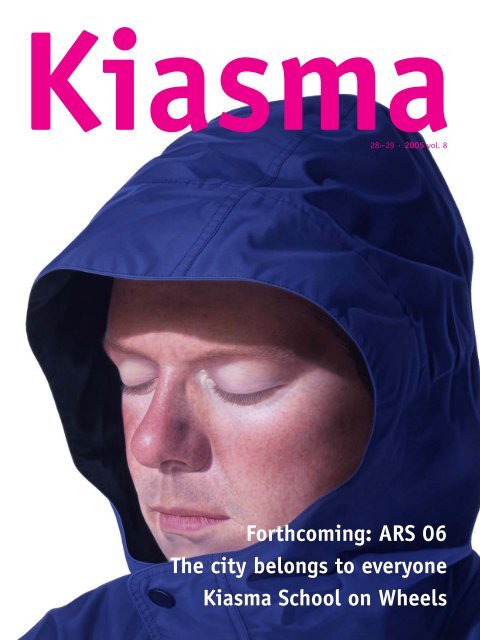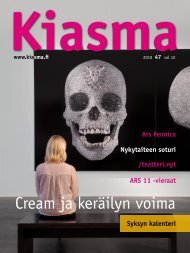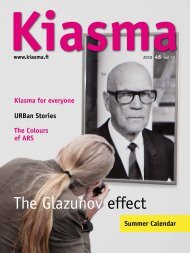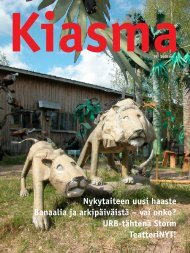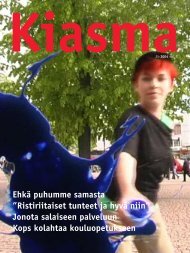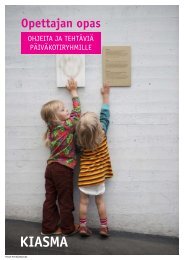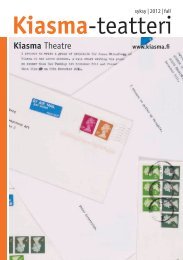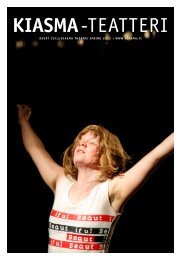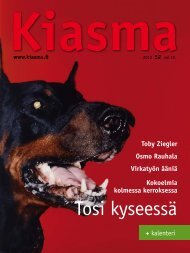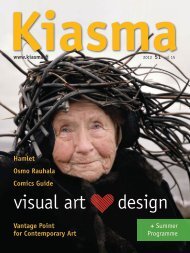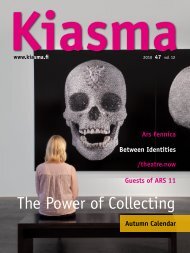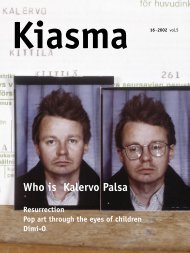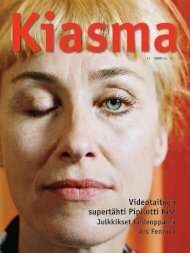Kiasma Magazine 28-29 PDF-version
Kiasma Magazine 28-29 PDF-version
Kiasma Magazine 28-29 PDF-version
You also want an ePaper? Increase the reach of your titles
YUMPU automatically turns print PDFs into web optimized ePapers that Google loves.
<strong>28</strong>-<strong>29</strong> · 2005 vol. 8<br />
Forthcoming: ARS 06<br />
The city belongs to everyone<br />
<strong>Kiasma</strong> School on Wheels<br />
<strong>Kiasma</strong><strong>28</strong>english3.indd 1<br />
22.8.2005, 15:58
Ed Templeton: Ann & DD jacuzzi<br />
ED TEMPLETON<br />
Skateboarding and travelling with skaters has given Ed Templeton a continuing, intimate<br />
access to young people’s lives. Documenting what goes on around him through photography<br />
and painting has been Templeton’s method of working as an artist all through his career.<br />
”Basically I am always around very young kids as a skateboarder. They are familiar with me<br />
as a pro skater, so I have a great access to them without being a stranger.”<br />
Ed Templeton depicts<br />
the life of American youth<br />
Ed Templeton’s photographic work has all<br />
to do with his travels and associations<br />
with the skateboard world. His photographs<br />
of skateboarders shooting guns,<br />
smoking, taking their first steps in their<br />
sexual lives and experimenting with drugs<br />
make use of the snapshot aesthetic<br />
but transcend photography as a memory<br />
backup and enter the realm of art.<br />
Similarly, Templeton’s board graphics and<br />
ads for Toy Machine - the Blood Sucking<br />
Skateboard company - go beyond selling<br />
a product. They communicate with the<br />
skateboard community on an equal level<br />
and comment on the consumption driven<br />
culture and the role of marketing in homogenizing<br />
our society.<br />
FAST LIVES<br />
Although he’s often labelled as a ’street<br />
artist’ or ’skateboard artist’ Templeton’s<br />
works have never been specifically about<br />
skateboarding and he has never been a<br />
graffiti writer. In a similar way that artist<br />
Nan Goldin’s photographs of her intimate<br />
circle of friends act as a window to a<br />
world of bohemian lifestyle, Templeton’s<br />
photographs of skateboarders’ lives talk<br />
about the wider reality of being young in<br />
today’s America.<br />
”I think by default the work is about<br />
youth: hard, fast lives fuelled by money<br />
at a young age, the coming of age, being<br />
a teenager, living in the suburban USA,<br />
relationships, travel… If you are a skateboarder,<br />
you will perhaps be able to take<br />
more away than someone who is not.<br />
But I want any person who sees it to<br />
take home a story from what I am doing.<br />
An outsider looking at these images can<br />
hopefully get a great inside look at youth<br />
and being human.”<br />
The photograph of Arto Saari in a hospital<br />
bed with a drip in his hand right after<br />
heart surgery at the age of just 17 is a<br />
touching portrait of the vulnerability of<br />
young life. It’s a photograph of one of<br />
the most respected professionals in skateboarding.<br />
There’s deep intimacy about it,<br />
seldom present in the image conscious<br />
representation of professional skaters.<br />
FROM SKATESHOP TO GALLERY<br />
The international skateboard community<br />
has been very supportive of its own.<br />
Skateboarders are interested in things that<br />
other skateboarders do in other fields.<br />
Art has also been an important part of<br />
the culture since the very beginning. Ed<br />
Templeton’s art started getting recognized<br />
outside the skateboard culture through<br />
his association with the New York based<br />
curator Aaron Rose and his Alleged<br />
Gallery in the 90’s. In 1999 an Italian<br />
collector bought his series of photographs<br />
called Teenage Smokers from his show at<br />
the Alleged. She then entered the series<br />
in a competition in Italy, where the series<br />
won the first prize. Sitting in the jury<br />
in Milan that time, among others, was<br />
Jerome Sans, the curator of Palais de<br />
Tokyo in Paris. Shortly after winning the<br />
prize in Milan, Templeton was invited to<br />
have a personal show in Palais de Tokyo.<br />
The widening scope of his audience hasn’t<br />
affected the way Templeton goes about his<br />
work or what he hangs in his exhibitions. ”I<br />
am doing the exact same stuff I always do.<br />
If anything, I can use these nice venues to<br />
expand and do bigger and better things.”<br />
Templeton’s current access to the nice<br />
venues hasn’t distanced him from his<br />
roots in skateboarding either. ”I just did<br />
a show in Vancouver at Rick McCrank’s<br />
2 <strong>Kiasma</strong><br />
<strong>Kiasma</strong><strong>28</strong>english3.indd 2-3<br />
22.8.2005, 15:58
<strong>Kiasma</strong><strong>28</strong>english3.indd 2-3<br />
22.8.2005, 15:58<br />
<strong>Kiasma</strong> 3
skateshop, AntiSocial. I never want to get<br />
to the point where I can’t do a show at a<br />
skateshop.”<br />
BEAUTIFUL LOSERS<br />
The work produced by the group of artists<br />
who started working with Rose in the early<br />
90’s and currently extensively displayed in<br />
a touring exhibition and an accompanying<br />
book, both titled Beautiful Losers, has since<br />
become known loosely as ’street art’.<br />
”People in general love to label things, and<br />
it does make things easier to digest. So this<br />
term ’street art’ goes way beyond graffiti into<br />
any kind of art someone does as long as that<br />
person is a surfer or skater. Very weird.”<br />
And while Templeton points out that there<br />
are many others, not associated with the<br />
movement around Alleged Gallery, doing similar<br />
things, it is predominantly the Beautiful<br />
Losers that have become to define ’street<br />
art’ in much of popular media internationally.<br />
The exposure of skateboarding artists like Ed<br />
Templeton and Mark Gonzales and the UK<br />
based Side Effects of Urethane Collective<br />
to a non-skate audience has done a lot<br />
for the wider understanding of skateboard<br />
culture. Similarly, the involvement with the<br />
art establishment has given a lot to skateboarding,<br />
and its favourite artists.<br />
© ED TEMPLETON © ED TEMPLETON<br />
But to swap a career in skateboarding for a<br />
career in art? ”I think about it all the time!<br />
But I am a Lifer. There is no stopping me<br />
from skateboarding. I love doing Toy Machine<br />
and plan on doing that until it goes out of<br />
business. I am getting older, and I am glad<br />
that I have other things to do with my time<br />
once my sponsors don’t need me anymore.<br />
But I will always skate.”<br />
Tuukka Kaila<br />
Skater and Artist<br />
Ed Templeton: Blue man painting, Swastika kid<br />
Ed Templeton was born in 1972 in Orange County, a suburb of Los Angeles. He<br />
got into skateboarding in his teens and became a professional skateboarder in<br />
1990. Templeton started his own skate company Toy Machine in 1993. Since then,<br />
he has been the president, team manager and art director of his company and<br />
continues to ride pro for them. At the same time, Ed Templeton has made a<br />
steadily growing career for himself as an exhibiting artist.<br />
Templeton’s works are part of the First We Take Museums exhibition.<br />
4 <strong>Kiasma</strong><br />
<strong>Kiasma</strong><strong>28</strong>english3.indd 4-5<br />
22.8.2005, 15:58
The city belongs to everyone<br />
First We Take Museums is an exhibition of urban art that in the wake of <strong>Kiasma</strong>’s URB<br />
festival continues to trace the essence of urban and street art. It is not an exhibition on<br />
street art, not even a post-graffiti exhibition. It discusses urban life and conflicts through<br />
art, often from a young people’s perspective.<br />
The exhibition title First We Take Museums<br />
refers to Leonard Cohen’s song First<br />
We Take Manhattan, lending a historical<br />
dimension to the title. <strong>Kiasma</strong> has always<br />
taken an interest in the complex and<br />
ambiguous relationship between visual<br />
culture and art. A dialogue between<br />
various phenomena poses a challenge to<br />
artists and museums alike.<br />
COLLECTION OF JEFFREY DEITCH<br />
The debate on street art and urban art<br />
has been delightfully lively and the city<br />
residents have adopted an active role in<br />
it. The artists’ contributions have formed<br />
a part of this debate, which instead of<br />
street credibility has focused on development<br />
of the urban space, aesthetics<br />
and politics. <strong>Kiasma</strong> has taken part in<br />
the debate in many ways, for example,<br />
in connection of the exhibitions Cities of<br />
the Move or Process - Encounters in Live<br />
Situations / Changing Spaces.<br />
First We Take Museums is a contemporary<br />
art exhibition that forms connections<br />
to the city and young people by way<br />
of phenomena in urban subcultures and<br />
youth culture. The exhibition makes no<br />
clear distinction between highbrow and<br />
lowbrow, and it does not attempt to<br />
exhaust or monopolise any urban or street<br />
art phenomena. Rather it wants to bring<br />
to the fore different views, create encounters<br />
that you either love or hate and<br />
provide a chance to talk, relax and spend<br />
time in the museum.<br />
First We Take Museums begins with Elvis<br />
and ends with skaters, whose art the<br />
London-based The Side Effects of Urethane<br />
Collective, who will be featuring in<br />
Karel Funk: Untitled, 2002<br />
<strong>Kiasma</strong> 5<br />
<strong>Kiasma</strong><strong>28</strong>english3.indd 4-5<br />
22.8.2005, 15:58
the exhibition, consider mainly outsider<br />
art. The collective will create a sculpture<br />
the size of <strong>Kiasma</strong>’s entire fifth floor, with<br />
a wave-like shape that reminds us of California<br />
surfers, who were the originators of<br />
skating culture. In an urban environment,<br />
different sub- and counter cultures exist<br />
in an ever-narrowing space, dictated by<br />
commercial interests and values of efficiency.<br />
Alternative lifestyles and movements<br />
are the source of urban creativity,<br />
and therefore in many ways indispensable.<br />
PETRI SUMMANEN<br />
Urban art forms often have political<br />
intent. Urban problems are universal and<br />
real. Urban art forms may well have the<br />
power to reveal and make us conscious<br />
of the space and the social agreements<br />
governing it. The First We Take Museums<br />
exhibition provides a floor for dialogue<br />
and a chance to rethink urban existence.<br />
In addition to the exhibition, the seminar<br />
Urban/Street Art and Public Discourse,<br />
jointly organised with the British Council,<br />
will address these questions.<br />
First We Take Museums continues where<br />
the URB Festival leaves off. It relentlessly<br />
asks us new questions. Will The Side<br />
Effects of Urethane’s sculpture turn the<br />
museum into one great big skating ramp?<br />
Virve Sutinen<br />
Head of Curator Team<br />
MIKKO SINERVO<br />
© THE SIDE EFFECTS OF URETHANE COLLECTIVE<br />
PETRI SUMMANEN<br />
6 <strong>Kiasma</strong><br />
<strong>Kiasma</strong><strong>28</strong>english3.indd 6-7<br />
22.8.2005, 15:58
There are many ways to understand contemporary art. Some<br />
like to contemplate quietly by the artwork. Others prefer to<br />
encounter art through their own action.<br />
<strong>Kiasma</strong> as an interface<br />
A museum visit is more than just that one visit. Visitors compare<br />
what they see and experience with what they have seen and<br />
experienced before. A museum visit underlines social aspects and<br />
creativity, one’s relationship with art and life in general. Open<br />
interaction with art is freedom to try out one’s ideas, skills and<br />
attitudes - without full certainty of where this might lead.<br />
First we take museums exhibition takes over the museum for<br />
action, making <strong>Kiasma</strong> a kind of interface with urban culture.<br />
The young urban art featured in the exhibition lives and progresses<br />
through processes. Therefore, the exhibition events and<br />
workshops emphasise the process-like character of art and one’s<br />
own action.<br />
Creating styles and presenting these different styles - putting<br />
oneself on show - is central to urban culture. First We Take<br />
Museums plays with styles and self-presentation. In the Tuning<br />
Workshops, recycled clothes are made into something new that<br />
represents the makers’ own views. You can further personalise<br />
your creations by using the workshop’s silkscreen print.<br />
The city is approached from many angles. The animation workshop<br />
is for searching for and creating one’s own interpretation<br />
of the urban environment. The Town Planning Seminar takes a<br />
theoretical approach to the urban space and the guided tours<br />
will bring additional substance to the exhibition. Skate Video<br />
workshops and city orienteering trips take the audience to the<br />
city at the very grassroots level.<br />
Riikka Haapalainen<br />
Acting Head of Education<br />
First We Take Museums<br />
10 Sep-20 Nov, Fifth floor and 4th floor<br />
The exhibition features 23 artists,<br />
and consists of concerts, workshops,<br />
performances and DJ shows.<br />
Artists<br />
Marc Bijl, Olaf Breuning, Olivier Dollinger,<br />
Johanna Domke, Karel Funk, Shaun<br />
Gladwell, Otto Karvonen, HK 119, Karri<br />
Kuoppala, Liisa Lounila, Alex McQuilkin,<br />
The Side Effects of Urethane Collective,<br />
Kambui Olujimi, Kristofer Paetau, Mike<br />
Paré, Janne Räisänen & Janne Siltanen,<br />
Bill Shannon, Tomoaki Suzuki, Ed<br />
Templeton, Dmitry Vilensky, Sislej Xhafa<br />
Guided tours Sun 3pm. In Finnish.<br />
Expert tours Wed 6pm. In Finnish<br />
Museum admission.<br />
14 Sep Patrick Nyberg, curator, 21 Sep,<br />
Virve Sutinen, Head of Curator Team, 19<br />
Oct Janne Räisänen, artist, 16 Nov Tuomas<br />
Toivonen, architect.<br />
Skateboarding times at the First We Take<br />
Museums exhibition Wednesdays 6-8pm.<br />
Inquiries and bookings at www.kiasma.fi<br />
More First We Take Museums programme<br />
see <strong>Kiasma</strong> calendar and www.kiasma.fi<br />
From recycling to tuning<br />
4-25 Oct, Fifth floor<br />
Part of First We Take Museums exhibition,<br />
this workshop is for designing and making<br />
new clothes from old ones. In collaboration<br />
with Emmaus. Museum admission.<br />
Art from the graffiti workshop<br />
26 Oct-13 Nov, Fifth floor<br />
Fruits of the graffiti workshop held<br />
at Annantalo arts centre. In collaboration<br />
with Myymälä2, Annantalo and<br />
Generation Vegetation exhibition.<br />
Museum admission.<br />
Toxic Dreams: Jabberwocky<br />
16-20 Nov, Fifth floor<br />
The Avanto festival features an installation<br />
performance by the Austrian group.<br />
Museum admission.<br />
<strong>Kiasma</strong> 7<br />
<strong>Kiasma</strong><strong>28</strong>english3.indd 6-7<br />
22.8.2005, 15:58
ILLUSTRATIONS Reetta Nykänen<br />
K<br />
ki rtok<br />
ou u<br />
”Thanks for coming!”<br />
The School on Wheels set off on its first<br />
school visit on <strong>29</strong> September 2003. Since<br />
then, it has visited 68 locations in five<br />
provinces, covering some 20,000 km. The<br />
teachers have carried the paraphernalia<br />
of the van - the technical equipment<br />
needed in the pedagogical performance,<br />
the artworks and workshop materials -<br />
into 76 auditoriums and back. The visits<br />
have been met with anything from puzzlement<br />
to excitement.<br />
A teacher once described pupils’ attitudes<br />
towards contemporary art as ranging from<br />
rejection and intolerance to acceptance<br />
and interest. <strong>Kiasma</strong>’s School on Wheels<br />
has not, according to feedback, made<br />
any major breakthrough but it has moved<br />
people’s minds. Although this three-year<br />
art education project is nearing its end,<br />
there are still nine school visits in the<br />
coming autumn which will show how contemporary<br />
art and school work can indeed<br />
be combined and in a fun way, to boot.<br />
<strong>Kiasma</strong>’s School on Wheels has attracted<br />
wide interest. It has made national news<br />
and in nearly every municipality it has<br />
visited, the local paper has covered the<br />
visit. The School on Wheels has been<br />
invited to teach at the teacher training<br />
departments of the University of Turku<br />
8 <strong>Kiasma</strong><br />
and The Chydenius Institute in Kokkola,<br />
and the multidisciplinarity of contemporary<br />
art has attracted great interest from<br />
teachers attending the courses organised<br />
at <strong>Kiasma</strong>. The School on Wheels has<br />
also been introduced in international art<br />
education seminars in London and Vilna.<br />
Last spring a group of Estonian youngsters<br />
and teachers had the opportunity to take<br />
part in the School on Wheels when the<br />
Finnish Institute in Estonia invited it for<br />
a week’s tour.<br />
At the end of 2005, the art education project,<br />
which has evoked praise, enthusiasm<br />
and amazement, as well as criticism and<br />
developmental suggestions, will finally<br />
be wrapped up. There will be a final<br />
report consisting of statistical information<br />
and research data produced in academic<br />
dissertations of the subject, as well as<br />
feedback gathered along the way. The<br />
feedback has been encouraging: ”More of<br />
this, please! Thanks for coming! What you<br />
do is so important!”<br />
Päivi Venäläinen<br />
producer<br />
<strong>Kiasma</strong> School on Wheels is a national<br />
three-year project supported by the<br />
energy company Vattenfall Oyj.<br />
www.kiasma.fi/kiertokoulu<br />
STATISTICS w 4 school terms<br />
4 Karstula, Viitasaari, Pihtipudas, Äänekoski,<br />
Laukaa, Tikkakoski, Jyväskylä, Muurame, Keuruu,<br />
Toivakka, Saarijärvi, Vaajakoski, Jämsä, Jämsänkoski,<br />
Palokka, Petäjävesi, Joutsa, Kuhmoinen,<br />
Toijala, Aitoo, Vammala, Nokia, Urjala, Ylöjärvi,<br />
Valkeakoski, Hämeenkyrö, Orivesi, Viiala, Halli,<br />
Juupajoki, Mänttä, Vilppula, Kihniö, Parkano,<br />
Virrat, Ruovesi, Kuru, Pirkkala, Pälkäne, Sysmä,<br />
Heinola, Padasjoki, Lahti, Humppila, Tammela,<br />
Riihimäki, Parola, Tervakoski, Kärkölä, Loppi,<br />
Nastola, Orimattila, Hämeenlinna, Isojoki, Kurikka,<br />
Peräseinäjoki, Teuva, Kauhajoki, Alavus, Ilmajoki,<br />
Lapua, Vimpeli, Evijärvi, Ylihärmä, Alajärvi,<br />
Soini, Ähtäri, Oulainen, Ruukki, Ylikiiminki, Kuivaniemi,<br />
Haukipudas, Kiiminki, Kuusamo, Taivalkoski,<br />
Nivala. Abroad: London, Vilnius, Tallinn, Rakvere<br />
and Tartu.<br />
4 School days 104<br />
4 Kilometres 19,539<br />
4 Teachers 471<br />
4 Educational performances 95<br />
4 Artist’s Anatomy performed 72 times<br />
4 Local artists featured 61 times<br />
<strong>Kiasma</strong><strong>28</strong>english3.indd 8-9<br />
22.8.2005, 15:58
ns<br />
LOcatio u t a<br />
Altoge ther<br />
StuDENTs<br />
9w n4 9´ C Ö<br />
ScHools<br />
Wor<br />
/van ÄECORations d<br />
<br />
,<br />
0<br />
. y m<br />
ksho 61<br />
<br />
<strong>Kiasma</strong><strong>28</strong>english3.indd 8-9<br />
22.8.2005, 15:58
Jan Kaila’s Porkkala series and its political message are<br />
directly connected to Finland’s political history and taboos.<br />
Kaila gave a talk on politics in art at the IAPL (International<br />
Association of Philosophy and Literature) Conference held<br />
at <strong>Kiasma</strong> in June.<br />
SAKARI VIIKA/CAA<br />
Who was Kolja?<br />
Jan Kaila: Porkkala 1944-56, detail<br />
In his talk Kolja and the Birch, Kaila discussed<br />
his Porkkala series displayed in the<br />
Fractures of Life exhibition, ”If you look<br />
closely, the name K O L J A inscribed with<br />
Russian letters is still discernible on a<br />
birch tree in the small village of Torsvik in<br />
Porkkala, twenty kilometres from Helsinki.<br />
Who was Kolja, and why and when did he<br />
carve his name on the tree?”<br />
When the President of Finland suddenly<br />
announced in 1944 that the Porkkala<br />
peninsula would be leased to the Soviet<br />
Union for 50 years, the 8,000 inhabitants<br />
had to leave their homes within two<br />
weeks. They did their best to secure their<br />
property. Things they could not take with<br />
them were either burnt or buried. Many<br />
thought they would never see their homes<br />
again. 25,000-40,000 Soviet troops and<br />
their families, plus a number of civilians<br />
replaced the Finnish inhabitants to work<br />
at the base. Porkkala became a kind of<br />
black hole, excluded from outsiders. The<br />
trains on the Helsinki-Turku line that<br />
ran through the area had to do so with<br />
covered windows. The section was known<br />
as the ’Porkkala tunnel’.<br />
But instead of 50 years later, the area<br />
was returned to Finland in 1956. Why<br />
did this happen? According to one explanation,<br />
the rapid development of nuclear<br />
weapons made army bases such as Porkkala<br />
redundant. Another theory goes<br />
that the Soviet Union used the gesture<br />
to support Urho Kekkonen’s presidential<br />
campaign. Be that as it may, the original<br />
residents returned in 1956 to see everything<br />
changed. Houses had been burnt<br />
down while new ones had been erected.<br />
The place had acquired a kind of magical<br />
or sinister atmosphere.<br />
MY PORKKALA<br />
Kaila said of his own relationship with<br />
Porkkala and thereby his works: ”I moved<br />
to Porkkala in 1980. It soon became clear<br />
to me that the area was full of hidden history.<br />
When I renovated our house, I found<br />
hundreds of pages of 1940s Pravda newspapers<br />
under the wallpaper. When I walked<br />
the fields, I would suddenly come across<br />
ammunition. At the end of the 1980s, I<br />
decided to make an artwork on the period<br />
1944-1956. I posted an ad in the local<br />
newspaper saying that I was interested in<br />
objects left behind by the Soviet troops.<br />
I got several responses and for a while I<br />
went from house to house photographing<br />
things ranging from Russian jewellery to<br />
personal diaries and letters. This lead to<br />
the work entitled 150 Russian Objects.<br />
In 1994 I was finally ready to put on an<br />
exhibition based on my Porkkala project.<br />
Many political changes had taken place<br />
since I started the project. The Soviet<br />
Union had collapsed, finally allowing an<br />
open debate about Porkkala. The story of<br />
Porkkala was no longer taboo - on the<br />
contrary, the local authorities are actually<br />
trying to turn the whole thing into a<br />
tourist attraction.<br />
But what about Kolja? If he is still alive,<br />
having survived the Stalin regime and adjusted<br />
to the new capitalist era, he is perhaps<br />
around 75 years old. I wonder if he still<br />
remembers the birch tree near the stable.”<br />
CHIASMATIC ENCOUNTERS<br />
The International Association of Philosophy<br />
and Literature IAPL held its annual<br />
conference in Helsinki 2-7 June 2005 and<br />
convened on Sunday at <strong>Kiasma</strong> to discuss<br />
’chiasmatic encounters’. The day consisted<br />
of two seminars, the first of which focused<br />
on <strong>Kiasma</strong>’s architect Steven Holl’s ideas<br />
on architecture.<br />
The afternoon seminar took its themes from<br />
the Fractures of Life exhibition. The session<br />
was chaired by Penny Florence, the Head of<br />
Research Programmes, The Slade School of<br />
Fine Art, University College London.<br />
Other speakers included Joanna Hodge,<br />
Professor of Philosophy, Manchester Metropolitan<br />
University, UK, Professor Jeremy<br />
Gilbert-Roffe, painter, Pasadena Art<br />
Centre, USA, and Jo Baer, artist. After the<br />
break, the Finnish artists Jan Kaila and<br />
Pekka Niskanen talked about their works<br />
and through them on the politics of art.<br />
Marja Sakari<br />
Senior Curator<br />
FRACTURES OF LIFE -<br />
Political Contemporary Art<br />
in <strong>Kiasma</strong> Collections<br />
2 April-27 November, 2nd and 3rd floor<br />
The free audio guide provides information<br />
about the works in the<br />
exhibition.<br />
Lempi evening 24 November 5-8pm<br />
Lempi and Lemmikki’s name day will<br />
be marked by a Lempi (Love) Evening<br />
where the discussion will be on happiness<br />
and richness in everyday life and<br />
the films screened are those we love.<br />
10 <strong>Kiasma</strong><br />
<strong>Kiasma</strong><strong>28</strong>english3.indd 10-11<br />
22.8.2005, 15:58
<strong>Kiasma</strong><br />
Calendar<br />
Anna Jermolaewa: 3` Attempts to Survive, 2000<br />
<strong>Kiasma</strong><strong>28</strong>english3.indd 10-11<br />
22.8.2005, 15:59
Exhibitions<br />
Expert tours on Wednesdays 6 pm. In Finnish.<br />
Museum admission. 14 Sep curator Patrik Nyberg,<br />
21 Sep Virve Sutinen, Head of Curator Team<br />
19 Oct Janne Räisänen, painter, 16 Nov Tuomas<br />
Toivonen, architect.<br />
Urban/Street Arts and Public Discourse<br />
seminar <strong>28</strong>-<strong>29</strong> October <strong>Kiasma</strong> Theatre<br />
A seminar organised in collaboration with the<br />
British Council, Myymälä2 and the Generation<br />
Vegetation exhibition on urban and street art.<br />
Speakers include Ian Boarden, who studies<br />
skateboard culture from the perspective of<br />
architecture.<br />
FIRST WE TAKE MUSEUMS<br />
10 Sep-20 Nov, Fifth and 4th floor<br />
HK 119: Neurotica, 2003, video<br />
Skateboarding times at the First We Take<br />
Museums exhibition Wednesdays 6-8pm.<br />
Inquiries and bookings<br />
at www.kiasma.fi<br />
First We Take Museums exhibition brings together different forms of urban culture and creates an<br />
open space for encounters and interaction to take place. Some twenty artists from Australia, Canada,<br />
Finland, France, Germany, United Kingdom, Japan, Netherlands, Switzerland and United States will<br />
participate in the exhibition. The exhibition will continue the themes of <strong>Kiasma</strong> Theatre’s urban festival<br />
in the field of visual culture. Just like the annual URB Festival, the exhibition manoeuvres in the<br />
middle ground between art and popular culture. The art institution becomes a stage for a variety<br />
of phenomena. p. 2<br />
Collections<br />
Bill Shannon<br />
11 Sep, 7pm<br />
Performance by the<br />
dancer-choreographer<br />
from the URB04 festival. Museum admission.<br />
From recycling to tuning<br />
4-25 Oct, Fifth floor<br />
Part of First We Take Museums exhibition,<br />
this workshop is for designing and making new<br />
clothes from old ones. In collaboration with<br />
Emmaus. Museum admission.<br />
Art from the graffiti workshop<br />
26 Oct-13 Nov, Fifth floor<br />
Fruits of the graffiti workshop held at Annantalo<br />
arts centre. In collaboration with Myymälä2,<br />
Annantalo, Generation Vegetation exhibition.<br />
Museum admission.<br />
Toxic Dreams: Jabberwocky<br />
16-20 Nov, Fifth floor<br />
The Avanto festival features an installation<br />
performance by the Austrian group. Museum<br />
admission.<br />
FRACTURES OF LIFE - Political Contemporary Art in <strong>Kiasma</strong> Collections<br />
2 April-27 Nov, 2nd and 3rd floor<br />
Art offers a path for considering the very<br />
issues that make life insupportable. In that<br />
sense, it offers us ways and means to understand<br />
life and different situations. Art also<br />
comments on the events and phenomena in<br />
our society. It can offer places to rest to offset<br />
a life filled with hectic work. Art can also serve<br />
as a retreat or create illusions about a better<br />
and more tolerable everyday life. p. 10<br />
Anna Jermolaewa: 3` Attempts to Survive, 2000<br />
The collection display will expand to Studio K,<br />
which as of 23 Sep will house Ossi Somma’s<br />
work The Last Equestrian Statue.<br />
Lempi evening 24 Nov, 5pm-8pm<br />
Lempi’s and Lemmikki’s name day will be<br />
marked at the Fractures of Life exhibition by<br />
a Lempi Evening (Love Evening) where the<br />
audience is welcome to join the discussion on<br />
the happiness and richness in everyday life<br />
and view some of the works we love.<br />
Forthcoming<br />
ARS 06<br />
from 21 Jan 2006<br />
<strong>Kiasma</strong>’s international exhibition ARS 06 focuses<br />
on art as an elemental part of humanity and<br />
opens up individual ways of explaining the world<br />
and ourselves. The central themes are the values<br />
and ideals of our time, our ability to be good<br />
and evil, as well as the capacity of art to offer<br />
consolation and touching experiences, a small<br />
miracle. p. 16<br />
<strong>Kiasma</strong><strong>28</strong>english3.indd 12-13<br />
22.8.2005, 15:59
CAMERON BARNETT<br />
Talks<br />
Meetings with artists<br />
Arranged in collaboration with the Friends of<br />
<strong>Kiasma</strong>, the meetings with artists take place<br />
every first Thursday of the month at 6 pm in the<br />
Seminar Room. Free admission. In Finnish.<br />
6 Oct, 3 Nov<br />
Philosophy of the Gaze:<br />
From forests to markets<br />
Series of talks, Wednesdays at 5pm in Seminar<br />
Room. Free admission. In Finnish. The autumn<br />
theme for talks by the Critical Academy and<br />
<strong>Kiasma</strong>’s is the city and urban environment.<br />
<strong>28</strong> Sep Panu Lehtovuori, D.Sc., architect: Towards<br />
experiential urban planning 5 Oct Riitta Nikula,<br />
professor of art history: The city and the living<br />
12 Oct Ritva Harle, community artist: This side of<br />
Pitkäsilta bridge, on the suburbia and art 26 Oct<br />
Minna Törmä, PhD, art historian: Chinese garden<br />
as a mindscape 2 Nov Pauline von Bonsdorff,<br />
professor of art education: Sound and touch in the<br />
urban space 9 Nov Jussi Kivi, artist: Wasteland<br />
OPEN READING CIRCLE Experience and reflection<br />
An open discussion series on the status of<br />
contemporary art in Finnish literary and philosophical<br />
debate. Fridays at 5.30 pm in the<br />
Seminar Room. In Finnish. Free admission.<br />
30 Sep Jaana Kokko, visual artist: My Romanticism<br />
7 Oct Johanna Oksala, philosopher, researcher:<br />
Thinking of violence, violence of<br />
thinking 21 Oct Riikka Pelo, screenwriter: Tragic<br />
thinking as a basis for screenwriting 11 Nov<br />
Elina Saloranta, visual artist: Do not disturb<br />
- thoughts on incompleteness 18 Nov Annamari<br />
Vänskä, art historian: Pornography research or<br />
pornographisation of research?<br />
<strong>Kiasma</strong> Theatre<br />
Dance by DocPoint 2-4 Sep<br />
2 Sep 6pm, 3 and 4 Sep 5pm and 7pm<br />
Dance by DocPoint screens a selection of<br />
Pina Bausch documentaries. Choreographer Pina<br />
Bausch’s individual idiom has generated a unique<br />
phenomenon in European dance theatre. Part of<br />
Helsinki Festival programme and the Nordrhein-<br />
Westfalen cultural year programme in Finland.<br />
www.docpoint.info Tickets EUR 5<br />
Quo Vadis: Objects & Emotions (Final <strong>version</strong>!)<br />
16 Sep 7pm premiere, performances 17 Sep 7pm<br />
and 18 Sep 3pm.<br />
This work represents Quo Vadis’s attempt at<br />
reinventing the theatre. Yet Quo Vadis is not<br />
a theatre, it is a dream of what theatre was<br />
supposed to be. Tickets EUR 12/8<br />
Hotinen, Mäki, Savikangas: Badminton Opera<br />
6 Oct 7pm premiere, performances 8 Oct 7pm,<br />
9 Oct 3pm, 12, 14 & 15 Oct 7pm and 16 Oct 3pm.<br />
The opera deals with violence, what violence is,<br />
how it is expressed, what it causes and what<br />
causes it. The work discusses the qualities, forms<br />
and characteristics of violence.<br />
Music: Max Savikangas; script, text, visualisation<br />
and direction: Teemu Mäki, Juha-Pekka Hotinen;<br />
production: The Museum of Finnish Contemporary<br />
Theatre, <strong>Kiasma</strong> Theatre. Tickets EUR 12/8<br />
Teatteri Venus: Mielenliikutuksia (Affections)<br />
9 Oct 2pm premiere, performances 16, 22, 23,<br />
27 & 30 Oct 2pm at Seminar Room<br />
Can the words of another reach a mind that<br />
is incapable of expressing itself? Is it possible<br />
to understand and recognise the feelings, needs,<br />
intentions of another person? Tickets EUR 12/8<br />
mouvoir/Stephanie Thiersch:<br />
Under Green Ground<br />
2., 3 and 4 Nov 7pm<br />
The German Stephanie Thiersch’s Under Green<br />
Ground introduces the invisible world where she<br />
creates her works. Stephanie Thiersch is particularly<br />
known for using video and multimedia as<br />
elements of dance choreography. Mouvoir’s visit<br />
is part of the Nordrhein-Westfalen cultural year<br />
2005 programme in FinlandPart of Moving in<br />
November festival programme. In co-operation<br />
with Tanzhaus NRW. www.liikkeellamarraskuussa.fi<br />
Tickets EUR 17/10 p. 15<br />
AVANTI! and contemporary music<br />
from Germany and France 21.-22 Oct<br />
Two of the most significant composers and makers<br />
of European contemporary music and theatre,<br />
the Paris-based Greek-born Georges Aperghis<br />
and the German Heiner Goebbels are guests at<br />
contemporary music weekend organised by the<br />
chamber music orchestra Avanti! which is led by<br />
the French conductor Diego Masson. The weekend<br />
will also include video screenings of the stage<br />
works by both composers. In collaboration with<br />
Goethe Institute and the French Cultural Centre.<br />
www.avantimusic.fi<br />
Avanto<br />
18-20 Nov<br />
Avanto festival for avant-garde film and<br />
experimental music takes a fresh look at art<br />
with the curiosity of a six-year-old. The new<br />
programme includes ’Avanto art’ that interests<br />
children, made by both children and adults.<br />
Full programme to be announced in the autumn.<br />
www.avantofestival.com<br />
Baltic Circle<br />
18-26 Nov<br />
The international theatre festival Baltic Circle is<br />
a network for theatre makers from the Baltic<br />
Sea Region. <strong>Kiasma</strong> hosts a workshop, Mekanika<br />
Popular, with the Serbian group Skart, producing<br />
a small-scale shadow theatre work.<br />
MARC UPSON<br />
ROTATION05 Dance and music video festival <strong>29</strong> Sep-2 Oct<br />
The Cost of Living<br />
Rotation05 presents Finnish and international dance and music videos from the past few years. In<br />
addition, a video dance course will be organised for Finnish choreographers in collaboration with<br />
Zodiak - the Centre for New Dance. Full programme see www.kiasma.fi<br />
Reality Research Centre: Zeckett II<br />
24 Nov 7pm premiere, performances 25 Nov 7pm,<br />
26, 27 Nov 3pm, 30 Nov 7pm, Kontti<br />
Zeckett II - on time and oblivion is a sequel to<br />
the company’s 2002 production Zeckett I - being<br />
and waiting. Tickets EUR 12/8 p. 22<br />
<strong>Kiasma</strong><strong>28</strong>english3.indd 12-13<br />
22.8.2005, 15:59
<strong>Kiasma</strong> Workshop<br />
Inquiries, please contact Kalle Hamm,<br />
tel. +358 (0)9 1733 6521, kalle.hamm@kiasma.fi<br />
FOR CHILDREN AND ADULTS<br />
Let’s make things together! On Saturdays<br />
10.30am-1pm and 2pm-4.30pm<br />
This is an opportunity for children and adults<br />
together to try out the limits of their creativity<br />
and skills. EUR 5.50, free of charge for children<br />
under 18.<br />
3 Sep I hereby declare…! -painting, silkscreen on<br />
T-shirt 10 Sep Working with templates 17 Sep The<br />
dark side - ink painting 24 Sep A story about my<br />
day - paper, collage, mixed media 1 Oct Everyday<br />
humour - paper, comics 8 Oct Beauty is in the eye<br />
of the beholder - portraits 15 Oct From skip to art<br />
- mobile 22 Oct Turncoats - dress design <strong>29</strong> Oct<br />
Myrsky ja mylväys! - letterpress printing 12 Nov<br />
Monsters’ Ball - plastic modelling and building<br />
The morning workshop registration as of 8 Aug,<br />
Mon-Fri 9am-12noon, tel. +358 (0)9 1733 6509.<br />
The afternoon workshop requires no registration.<br />
The group gathers at 2pm by the info desk, where<br />
we will proceed to the workshop, where you can<br />
also join the group later if there is room.<br />
FOR ADULTS<br />
With friends<br />
A workshop intended for groups of friends, or<br />
people sharing the same workplace or hobby.<br />
The workshop includes a visit to the exhibition<br />
and working at the Workshop. The workshops are<br />
usually on Fridays. Lasting about three hours,<br />
the workshops take 10 to 15 participants. Fee<br />
EUR 13/person, which includes the admission,<br />
materials and instruction. Inquiries/bookings tel.<br />
+358 (0)9 1733 6521.<br />
For schools<br />
WORKSHOPS<br />
ABC Workshops in Sep<br />
1-6 graders<br />
The ABC Workshops on contemporary art comprise<br />
three visits to <strong>Kiasma</strong>. The first is a guided tour<br />
to Fractures of Life exhibition. The second and<br />
third visits involve workshop activities, learning<br />
about the materials and techniques used in contemporary<br />
art. Max 15 participants.<br />
Registration as of Monday <strong>29</strong> Aug 1pm,<br />
tel. +358 (0)9 1733 6513. Free of charge.<br />
From recycling to tuning in Oct<br />
5-9 graders, upper secondary schools<br />
In the workshop connected to the First We Take<br />
Museums exhibition, students can design and<br />
make new clothes out of old ones. The ’tuned’<br />
clothes can also be silkscreened with personal<br />
motifs. Groups are divided into three parts<br />
circulating between the workpoints. Max 15<br />
participants. Registration as of Monday <strong>29</strong> Aug<br />
1pm, tel. +358 (0)9 1733 6513. Free of charge.<br />
Statements<br />
Fri <strong>28</strong> Oct 5pm-8pm, 13-18-year-olds<br />
The workshop is for making short animations with<br />
a digital video camera. The starting point is the<br />
urban environment and different phenomena in<br />
it. No previous experience in making animations or<br />
using the equipment required. Max 12 participants,<br />
in the order of registration. Registration as of<br />
Monday 3 Oct 10am, tel. +358 (0)9 1733 6513.<br />
Free of charge.<br />
GUIDED TOURS FOR SCHOOL GROUPS<br />
Guided tours can be booked for the collection<br />
display and the temporary exhibitions. If you<br />
wish, you can ask the guide to discuss the<br />
exhibition from a specific angle of your choice.<br />
Guide bookings on weekdays 9am-12noon, tel.<br />
+358 (0)9 1733 6509. Guided tours are free for<br />
school groups on weekdays. If your class needs<br />
somewhere to eat packed lunches or exercise,<br />
please mention this when booking.<br />
Dedicated guides for schools<br />
<strong>Kiasma</strong> offers a special service to schools who<br />
visit <strong>Kiasma</strong> regularly, provided the school has<br />
at least three teachers of different subjects,<br />
who would like to use <strong>Kiasma</strong> in their teaching.<br />
The school will have its own guide who introduces<br />
the exhibitions to the teachers and helps plan<br />
the exercises given to the pupils. For more<br />
information, see www.kiasma.fi/kouluille<br />
Info<br />
GUIDED TOURS<br />
Guided tours to Fractures of Life exhibition in<br />
Finnish on Fri 6 pm.<br />
Guided tours to First We Take Museums exhibition<br />
in Finnish Wed 6pm and Sun 3pm.<br />
Tours in Swedish are held on the first Sunday<br />
of each month at 12 noon.<br />
Tour bookings<br />
Tour bookings Mon-Fri 9am-12noon, tel. +358<br />
(0)9 1733 6509. Prices on weekdays EUR 55<br />
and Sundays EUR 68. Tours are given in Finnish,<br />
Swedish, English, French, German, Estonian or<br />
Russian.<br />
Contact guides available in exhibition<br />
Tue 10am-4pm, Wed-Thu 12-6pm, and Fri<br />
2pm-8pm.<br />
KIASMA<br />
Mannerheiminaukio 2, 00100 Helsinki, Finland.<br />
Opening hours Tue 9am to 5pm, Wed–Sun 10am<br />
to 8.30pm, Mon closed.<br />
Admission EUR 5.50/4, under 18s free, Fridays<br />
5pm–8pm entrance free. In <strong>Kiasma</strong> Theatre prices<br />
vary according to the event.<br />
Info Tel. +358 (0)9 1733 6501, info@kiasma.fi<br />
www.kiasma.fi<br />
The building is fully accessible. Guide dogs are<br />
welcome. The ticket office and Theatre have an<br />
induction loop system.<br />
The Museum of Contemporary art is part of the<br />
Finnish National Gallery.<br />
WE ARE BUILDING ARS 06<br />
Exhibition floors are closed<br />
<strong>28</strong> Nov 2005-20 Jan 2006<br />
KIASMA STORE<br />
Exhibition catalogues, books, magazines,<br />
and <strong>Kiasma</strong> products.<br />
Open Tue 9am to 5pm, Wed–Sun 11am to 7pm,<br />
Mon closed. Tel. +358 (0)9 1733 6505<br />
CAFÉ KIASMA<br />
The café/restaurant on the ground floor.<br />
Open Tue 10am–5pm, Wed-Sun 10am–9pm.<br />
Tel. +358 (0)9 1733 6504.<br />
FRIENDS OF KIASMA<br />
For more information on the activities<br />
of Friends of <strong>Kiasma</strong>, please call<br />
+358 (0)9 1733 6595.<br />
All information is subject to change.<br />
<strong>Kiasma</strong><strong>28</strong>english3.indd 14-15<br />
22.8.2005, 15:59
TOM SCHREIBER<br />
Solo for four<br />
Stephanie Thiersch, the Cologne-based<br />
choreographer, has created a fresh and<br />
clever dance work Under Green Ground. She<br />
introduces an invisible world where works<br />
of art are created. The performance overlaps<br />
the time before and after curtain-up.<br />
A joint creation by Stephanie Thiersch and<br />
dancer Alexandra Naudet, Under Green<br />
Ground is a solo work in which Naudet<br />
is accompanied on stage by three other<br />
dancers. The audience finds itself following<br />
both the show and preparation for<br />
the show simultaneously. The production<br />
crosses the boundary that separates<br />
staging and performance.<br />
As the virtuoso ’roadies’ let loose to the<br />
music of Madonna while building the set,<br />
Naudet performs multidimensional images<br />
of women known from paintings and pop<br />
culture. Her expressive dance and believable<br />
performance draws the audience in<br />
with its simplicity and appeal. Dancing<br />
and building go on side by side, sometimes<br />
ignoring, and sometimes disturbing<br />
each other.<br />
Stephanie Thiersch is renowned for her<br />
use of video and multimedia as elements<br />
in choreography. Thiersch conjures up<br />
changing moods, atmospheres, and<br />
situations, creating a hybrid performance<br />
on the border between live action and<br />
video installation. In Under Green Ground,<br />
technology is used in an impressive light<br />
and sound display. The music of the<br />
performance mostly consists of pop music<br />
and evergreens.<br />
Born in Wiesbaden, Germany, in 1970,<br />
Thiersch studied English, Romance<br />
languages, and literature as well as<br />
communications before settling on dance<br />
studies. She has been a member of<br />
several independent and international<br />
dance groups. In 1997, when she established<br />
the mouvoir dance group, which<br />
has come to be known for its merge of<br />
dance, theatre, media and video art and<br />
music.<br />
Aleksandra Naudet is well-known for<br />
the rare expressive quality of her work,<br />
and as a member of the French dance<br />
group, DAC/Philippe Decouflé. Under<br />
Green Ground is a solo work made for<br />
her, extending from dance into a kind of<br />
tableaux vivants performance, presenting<br />
images through living human beings.<br />
Before arriving in Helsinki, the work<br />
toured in Germany and South America.<br />
From Helsinki, it will continue on to<br />
Mulhouse, France.<br />
mouvoir/Stephanie Thiersch:<br />
Under Green Ground<br />
<strong>Kiasma</strong> Theatre 2, 3, and 4 Nov 7pm<br />
Part of the Moving in November<br />
festival programme. In co-operation<br />
with Tanzhaus NRW<br />
Tickets 17/10 euros<br />
Alexandra Naudet<br />
<strong>Kiasma</strong> 15<br />
<strong>Kiasma</strong><strong>28</strong>english3.indd 14-15<br />
22.8.2005, 15:59
ARS 06<br />
Playing with<br />
serious matters<br />
The Swiss artist couple Gerda Steiner and Jörg Lenzlinger came to Helsinki<br />
in the heat of July to gather material for their work to be displayed at ARS 06<br />
exhibition. For two weeks, they scoured the environs of Helsinki, Juupajoki and<br />
Joutseno and came up with the material they needed.<br />
PETRI VIRTANEN/KKA<br />
16 <strong>Kiasma</strong><br />
Jörg Lenzlinger and Gerda Steiner<br />
<strong>Kiasma</strong><strong>28</strong>english3.indd 16-17<br />
22.8.2005, 15:59
Steiner and Lenzlinger’s large-scale installations<br />
are always specifically designed for<br />
the given exhibition space, and the materials<br />
may range from wild plants to crystals<br />
and plastic flowers. Imaginary gardens<br />
and fairytale worlds fill up, exploit and<br />
shape the entire surrounding space. For<br />
ideas, the couple studies not only the<br />
exhibition space, but also local history,<br />
culture and folklore.<br />
© STEINER & LENZLINGER<br />
Steiner and Lenzlinger’s works are also<br />
often full of playfulness and irony. For<br />
example, the installation created in 2003<br />
for La Casa Encendida in Madrid, How Did<br />
the Walrus get to Madrid? began with a<br />
visit to Madrid’s Museum of Natural History.<br />
There the artist couple met half of a<br />
stuffed walrus named Lolita, and were left<br />
wondering how it got to Madrid, which<br />
was inland, and what ever happened to<br />
the rest of it. Lolita was eventually let out<br />
of the museum to feature in the artwork<br />
and was placed in a maritime surrounding<br />
consisting of different natural materials.<br />
The thought of a walrus may be amusing,<br />
but the theme of the work is serious, as<br />
it tells about rootlessness and detachment.<br />
The eggplant foliage was gathered from<br />
El Edijo greenhouses, where much of the<br />
vegetables eaten by Europeans over the<br />
winter are grown, tended by immigrant<br />
workers. ”We want to turn things upside<br />
down and tell stories. For example, in<br />
Finnish folklore, the fox is a clever animal,<br />
so we could make a work where it would<br />
be depicted as stupid,” the artists say. The<br />
fun in Steiner and Lenzlinger’s works comes<br />
usually from turning things upside down.<br />
At the same time, they invite the audience<br />
to view things from a new perspective.<br />
The Hanging Garden, 2003<br />
© STEINER & LENZLINGER<br />
FAIRYTALE GARDENS AND<br />
ENVIRONMENTAL ISSUES<br />
The space is a central element in Steiner<br />
and Lenzlinger’s works, as the works are<br />
designed and built for a specific space. So,<br />
the exhibition space is actually part of the<br />
work. The Hanging Garden featured at the<br />
Church of San Staë during the 2003 Venice<br />
Biennale filled the white building, which a<br />
doge had built as his final resting place,<br />
with a plethora of materials and studied<br />
the atmosphere of the church. There were<br />
fake flowers, pig’s teeth, seaweed and<br />
banana leaves hanging from the ceiling<br />
Root Treatment, 2004<br />
<strong>Kiasma</strong> 17<br />
<strong>Kiasma</strong><strong>28</strong>english3.indd 16-17<br />
22.8.2005, 15:59
© STEINER & LENZLINGER<br />
built a fake flower garden. Gradually the<br />
saline dripping from the roots crystallised<br />
and made the flowers underneath seem<br />
like they were covered in snow. Salt is<br />
both necessary and detrimental to life.<br />
Although plants need nutrients, intensive<br />
farming has led to the excessive salinisation<br />
of the soil, and not just in Israel.<br />
A SWING OR A NEST ?<br />
The two weeks Steiner and Lenzlinger<br />
spent in Finland included trips to Juupajoki<br />
and Joutseno. They gathered great<br />
amounts of natural materials from the<br />
forest. The artist couple also familiarised<br />
themselves with Helsinki and its surroundings<br />
and the Finnish lifestyle and<br />
folklore.<br />
and the audience could walk in the space<br />
or lie on a bed on top of the doges tombstone<br />
and admire the garden above. ”We<br />
want our audience inside our works, not<br />
just looking at them from the outside,”<br />
say the artists.<br />
Another central element in Steiner and<br />
Lenzlinger’s works is nature, present in<br />
the works from the choice of materials.<br />
Some of the works comment on nature<br />
and environmental issues, often by way<br />
of humour. Les envahisseurs (The Invaders,<br />
2004) was created for Geneva botanical<br />
gardens, or in fact in a container in front<br />
of it. The idea came from invader plants<br />
that spread into new habitats and steal<br />
the living space from the area’s original<br />
vegetation. The garden built inside the<br />
container was in fact a testing ground<br />
for what would happen if all sorts of<br />
plants, flowers, herbs and endangered<br />
grasses were planted in the same space.<br />
The plants were planted in old suitcases,<br />
handbags and shoes.<br />
Environmental issues are close to Steiner<br />
and Lenzlinger’s hearts. ”We have travelled<br />
PETRI VIRTANEN/KKA<br />
Root Treatment, 2004<br />
Jörg Lenzlinger and Gerda Steiner<br />
the world and seen many different kinds<br />
of environments and also environmental<br />
problems. You Finns will be so rich one<br />
day, with all this water at your disposal,”<br />
the artists pointed out. Their work Root<br />
Treatment created for Tel Aviv Art Museum<br />
in 2004 discusses the lack of water and<br />
arable land, which in much of the world<br />
is a burning daily question. The artists<br />
borrowed plants that do not grow on soil<br />
as their roots hang in the air and they<br />
are fed with a mixture of water and<br />
nutrients. Beneath the roots, the artists<br />
For artists, closeness to nature and tranquillity<br />
were qualities that were particularly<br />
attractive in Finland. ”People<br />
are part of nature and we should take<br />
responsibility for our environment. I love<br />
how nature is so close here. The forest<br />
starts almost from the city centre,” the<br />
artists enthuse.<br />
The <strong>Kiasma</strong> premises also impressed the<br />
artists, who already have ideas of what<br />
kind of work they would like to build in<br />
the tall church-like lobby space. Steiner<br />
would like a swing in which the audience<br />
could lie down, with a hanging garden<br />
above, while Lenzlinger has been thinking<br />
about a bird’s nest into which the audience<br />
could climb. A third idea is a spring,<br />
with stuffed animals around it. The<br />
audience would peek into the spring side<br />
by side with animals. It remains to be<br />
seen, whether any of these ideas will<br />
see daylight, or whether there will be<br />
completely new plans.<br />
<strong>Kiasma</strong>’s storage rooms now have a large<br />
amount of material awaiting the artists<br />
who have returned to Switzerland to work<br />
on their ideas. Steiner and Lenzlinger’s<br />
work will acquire its final form in December,<br />
when the work’s erection begins.<br />
”Although we have ideas and the material<br />
is there, the work itself is always ultimately<br />
improvisation,” the artists conclude.<br />
Auli Karra<br />
18 <strong>Kiasma</strong><br />
<strong>Kiasma</strong><strong>28</strong>english3.indd 18-19<br />
22.8.2005, 15:59
ARS 06<br />
This year’s Venice Biennale International Art Exhibition also featured two artists invited<br />
to the ARS 06 exhibition: Willie Doherty, Ireland, and Jun Nguyen-Hatsushiba, Japan.<br />
<strong>Kiasma</strong> <strong>Magazine</strong> met them in sunny Venice.<br />
ARS artists<br />
appeared in Venice<br />
PIIA LAITA<br />
became a hotbed of controversy between<br />
Protestants and Catholics. The incident<br />
was dramatised for television and the<br />
actor playing the scapegoat also appears<br />
in Doherty’s work. ”The actor in the BBC<br />
drama gives a face to the threat. The aim<br />
of my works is to depict threat and find<br />
a language to describe it.”<br />
PIIA LAITA<br />
Willie Doherty<br />
Willie Doherty lives in Derry, a small town<br />
in Northern Ireland. The situation in the<br />
area is the key to his work. ”I would<br />
not describe myself as a political artist,<br />
although the starting point for my works<br />
is the Northern Ireland situation. I think<br />
being political means choosing a particular<br />
perspective.”<br />
ARS 06 displays Doherty’s video installation<br />
Non-Specific Threat, which was also<br />
seen in Venice. The video focuses on<br />
a young man around whom the camera<br />
revolves. The work is based on stereotypes<br />
of terrorists as conveyed in the media.<br />
Although the man does not behave in a<br />
threatening manner, the viewer will<br />
associate him with violence.<br />
The idea of the work comes from an<br />
incident in Belfast a couple of years ago,<br />
when pupils were stopped from going<br />
to a North Belfast Primary School that<br />
Doherty says working in Derry has two<br />
dimensions. On the one hand, the locality<br />
and the conflicts in it provide a wealth of<br />
topics to discuss. On the other, living in<br />
a slightly remote location distances him<br />
from the art world. ”International exhibitions,<br />
such as ARS 06, are a way for me<br />
to be part of a larger whole.”<br />
HISTORY UNDER WATER<br />
The works of Jun Nguyen-Hatsushiba, who<br />
was born in Japan, educated in the U.S.<br />
and currently resides in Vietnam, show<br />
the influence of the three cultures. ”My<br />
cultural background is evident in my works.<br />
They are informed by the history and past<br />
experiences of these three countries.”<br />
Nguyen-Hatsushiba’s video works move in<br />
the underwater world and they discuss the<br />
recent history of Asia. The racing underwater<br />
rickshaws refer to the slow recovery<br />
of Vietnam from the chaos caused by<br />
decades of war and political turmoil. The<br />
other work is connected to the 1968<br />
assault when the North Vietnamese troops<br />
struck during the most important holiday<br />
of the year, the New Year, despite a<br />
truce. The artist describes the problematic<br />
Jun Nguyen-Hatsushiba<br />
relations between the U.S., Vietnam and<br />
Japan in his work Okinawa. ”The locations<br />
of the works play a major role, they have<br />
to support the history.”<br />
Getting used to working underwater took<br />
its time. ”I had never scuba dived before,<br />
so when shooting my first work, I had<br />
to learn how to move and behave underwater.<br />
I am still a little scared in the first<br />
few days of a shoot.”<br />
Although Nguyen-Hatsushiba’s works are<br />
based on historical conflicts, their underwater<br />
setting also has dreamlike beauty.<br />
”Art should have an element of beauty,<br />
that’s why it’s called art.”<br />
Piia Laita<br />
<strong>Kiasma</strong> 19<br />
<strong>Kiasma</strong><strong>28</strong>english3.indd 18-19<br />
22.8.2005, 15:59
ARS 06<br />
Baby steps to ARS<br />
Do you often get lost in <strong>Kiasma</strong>? Is there an exhibition here that is<br />
always on show? How long have you been working in <strong>Kiasma</strong>?<br />
These tough questions were pencilled on pieces of paper by Kirsi,<br />
Kaisa and Teemu from Vironniemi kindergarten. Their expedition<br />
team ’Polly wants a chocolate biscuit’ came to <strong>Kiasma</strong> in May to<br />
interview for the kindergarten’s Viesti (Message) magazine.<br />
The interview would be the first of many joint activities <strong>Kiasma</strong><br />
and the kindergarten would undertake in connection with ARS.<br />
The children will delve deeply into contemporary art during the<br />
coming autumn and spring. The fruits of the project will be for all<br />
museum visitors to see in the forthcoming exhibition. A number<br />
of children from Vironniemi will serve as ARS guides assisted by<br />
adult guides as part of the children’s event of spring 2006.<br />
But the Vironniemi children are not the only ones training as<br />
museum guides for ARS. <strong>Kiasma</strong> is also starting a project with art<br />
schools in Espoo and Vantaa, in which the young students will<br />
run ARS workshops for other children of their age.<br />
REVERSING THE ROLES<br />
So are ARS organisers short of competent staff, or why do they<br />
train so many new guides? Not really. <strong>Kiasma</strong>’s team of some<br />
twenty competent and inspired guides is still there, happy to tell<br />
all ARS visitors, regardless of age, about the works<br />
and discuss<br />
them. ’Peer guides’ will, however,<br />
provide something extra to the interaction between art and<br />
the audience. For children to be guided by someone of their<br />
own age may help create a much more personal relationship with<br />
contemporary art as their experiential backgrounds and aesthetic<br />
development stages are closer to one another.<br />
But the adult ARS audience is also offered a more pluralistic<br />
approach. This means that the art works are not just presented<br />
from the perspective of the established canon of art. Instead,<br />
new approaches to contemporary art and contemporary interpretations<br />
are actively sought. A philosopher, social scientist,<br />
psychologist, or why not even a clergyman, politician or a lay<br />
person, may take on the role of a guide and take visitors on a<br />
completely different kind of tour through the exhibition.<br />
The guided tour programme for ARS may turn out to be an<br />
exploration into a new kind of museum talk, where the<br />
established expert’s voice is toned down. The themes of ARS<br />
are not exhausted by a single visit, its contents are in constant<br />
flux and take on different meanings, depending on the guide.<br />
Riikka Haapalainen<br />
Acting Head of Education<br />
JENNI NURMINEN/CAA<br />
20 <strong>Kiasma</strong><br />
<strong>Kiasma</strong><strong>28</strong>english3.indd 20-21<br />
22.8.2005, 15:59
ARS 06<br />
Join the club!<br />
ARS Club is a new link between <strong>Kiasma</strong> and organisations<br />
and companies, inexpensive and fun. The ARS Club programme<br />
offers member organisations’ employers and partners reviving<br />
experiences, stirs up their creativity and helps make new<br />
contacts.<br />
The Club members have access to different events in line with the<br />
prolific programme of ARS 06, ranging from parties to lectures,<br />
workshops to meditation sessions and children’s events. Friends<br />
of <strong>Kiasma</strong> will also contribute to the fun by inviting ARS Club<br />
members to their own functions.<br />
Membership in ARS Club gives visibility in <strong>Kiasma</strong> <strong>Magazine</strong>, a<br />
link from <strong>Kiasma</strong> website and invitations to various exclusive<br />
ARS events, such as the pre-opening of ARS exhibition. Moreover,<br />
ARS Club members can rent <strong>Kiasma</strong> premises at a reasonable cost<br />
for their own use, and buy tickets and ARS products at special<br />
prices.<br />
ARS Club membership is an opportunity to approach contemporary<br />
art from many aspects, and it offers a completely<br />
new way for businesses to network. ARS Club will be marketed to<br />
companies and other organisations in the Helsinki metropolitan<br />
area during the coming autumn. At the same time, ARS Club’s<br />
own website www.kiasma.fi/ars-klubi will be launched.<br />
ARS 06<br />
21 January-27 August 2006 <strong>Kiasma</strong><br />
The central themes of ARS 06 are the<br />
values and ideals of our time, our ability<br />
to be good and evil, as well as the<br />
capacity of art to offer consolation and<br />
touching experiences, a small miracle.<br />
Some 40 contemporary artists from all<br />
over the world have been invited to<br />
join the exhibition. The ARS programme<br />
includes seminars, workshops, lectures<br />
and a series of performance at <strong>Kiasma</strong><br />
Theatre.<br />
Exhibition team Chair: Tuula Karjalainen,<br />
PhD, Director of <strong>Kiasma</strong>; other members:<br />
Kati Kivinen, exhibition coordinator,<br />
Patrik Nyberg, curator, Marja Sakari, senior<br />
curator, and Jari-Pekka Vanhala, curator.<br />
The ARS programme at <strong>Kiasma</strong> Theatre is<br />
compiled by Virve Sutinen, producer.<br />
The exhibition content, artists and art<br />
is presented in an exhibition publication,<br />
edited by Marja Sakari and Jari-Pekka<br />
Vanhala.<br />
The exhibition design, created by Taivas<br />
Design, will embellish several products,<br />
<strong>Kiasma</strong> itself and the streetscape.<br />
The first ARS exhibition was organised<br />
in Helsinki in 1961, and ARS 06 is the<br />
seventh ARS exhibition.<br />
<strong>Kiasma</strong> 21<br />
<strong>Kiasma</strong><strong>28</strong>english3.indd 20-21<br />
22.8.2005, 15:59
LNNBERG_ILMO<br />
Tulossa<br />
Theatre of the<br />
bodily and the<br />
experiential<br />
Reality Research Centre’s Zeckett II - on time and oblivion is a<br />
sequel to the company’s 2002 production Zeckett - being and<br />
waiting performed on the outdoor stage of Esplanadi park. The<br />
project’s name is a combination of the words ’Zen’ and ’Beckett’<br />
and, discussing the relationship between time and being, it has<br />
been influenced by Zen philosophy and Samuel Beckett’s work,<br />
as well as the philosopher Martin Heidegger’s thinking.<br />
The performance is based on the idea of Western thinking being<br />
merely instrumental and on the attempt to achieve a more<br />
authentic mode of being. The only essential thing is, what is<br />
present at this moment, conceptual thinking has no place in the<br />
a day & night on the<br />
F I F T H<br />
F L O O R<br />
24.11.- 11.12.<br />
NIKO LUOMA<br />
Käytä ainutlaatuinen tilaisuus<br />
ja vuokraa <strong>Kiasma</strong>n Viides kerros<br />
omaan käyttöösi.<br />
www.kiasma.fi/viideskerros<br />
Palvelut<br />
kokonaisviestinnän hallintaan<br />
ja<br />
toimintaympäristön havainnointiin.<br />
performance. The method in Zeckett is the ’aesthetics of silence’,<br />
which emphasises the immediate, holistic and flowing nature of<br />
existence.<br />
It shares the Zen idea of action in the present being essential,<br />
action that primarily is experiential, not conceptual. Zen art does<br />
not attempt to represent the world, it merely gives it a chance to<br />
come into view. Therefore, Zeckett may be difficult to understand<br />
in a conceptual sense, the experience is what matters.<br />
Reality Research Centre:<br />
Zeckett II - on time and oblivion<br />
Premiere 24 Nov at 7pm, Kontti<br />
Other performances 25 Nov, 7pm, 26 and 27 Nov 3pm,<br />
and 30 Nov 7pm.<br />
Tickets 12/8 euros<br />
Kokoamme päätöksenteon kannalta<br />
oleellisen tiedon.<br />
Sinä teet päätökset.<br />
Merimiehenkatu 36 D, 00150 Helsinki<br />
puh. (09) 686 131<br />
info@observer.fi | www.observer.fi<br />
22 <strong>Kiasma</strong><br />
<strong>Kiasma</strong><strong>28</strong>english3.indd 22-23<br />
22.8.2005, 15:59<br />
HS_24h_210x138_
LNNBERG_ILMO_210X138 <strong>28</strong>.7.2005 12:25 Page 1<br />
tästä elämästä.<br />
<strong>Kiasma</strong><strong>28</strong>english3.indd 22-23<br />
22.8.2005, 15:59<br />
HS_24h_210x138_.indd 1 <strong>28</strong>.6.2005 14:53:26
<strong>Kiasma</strong><br />
<strong>28</strong>-<strong>29</strong><br />
2<br />
8<br />
Pro skater and artist Ed Templeton: ”There is no stopping me<br />
from skateboarding.”<br />
<strong>Kiasma</strong>’s School on Wheels set off on its first school visit on<br />
<strong>29</strong> September 2003. Since then, it has visited 68 locations in five<br />
provinces, covering some 20,000 km.<br />
COVER: KAREL FUNK: Untitled, 2004, Thea Westreich and Ethan Wagner<br />
11 Calendar<br />
15 <strong>Kiasma</strong> Theatre’s international guest coreographer Stephanie Thiersch<br />
has created a fresh and clever dance work Under Green Ground.<br />
16 ARS 06 The Swiss artist couple Gerda Steiner and Jörg Lenzlinger<br />
came to Helsinki in the heat of July to gather material for their work<br />
to be displayed at ARS 06. For two weeks, they scoured the environs<br />
of Helsinki, Juupajoki and Joutseno and came up with the material<br />
they needed.<br />
<strong>Kiasma</strong> magazine | Publisher: Museum of Contemporary Art | Editor in Chief: Communications Manager Piia Laita +358 (0)9 1733 6507 | Subeditor: Press Officer Päivi Oja +358 (0)9 1733 6534 | Web: Network<br />
Media Manager Justus Hyvärinen +358 (0)9 1733 6532 | Address: <strong>Kiasma</strong>, Museum of Contemporary Art, Mannerheiminaukio 2, 00100 Helsinki, Finland | Tel. +358 (0)9 173 361, Fax +358 (0)9 1733 6503 |<br />
Internet: www.kiasma.fi | E-mail: kiasma-lehti@kiasma.fi | ISSN 1456-9124 | Graphic Design: Timo Vartiainen | Lay-out: Reetta Nykänen | Printed at F.G. Lönnberg | The schedules of exhibitions and events<br />
are subject to change. | CONTACT PERSONS | Museum Director Tuula Karjalainen, Director’s Assistant Tuula Vuorio, Tel. +358 (0)9 1733 6516, Fax +358 (0)9 1733 6574 | Exhibitions: Senior Curator Marja<br />
Sakari 09-1733 6519 | <strong>Kiasma</strong> Theatre: Producer Virve Sutinen +358 (0)9 1733 6511 | Head of Marketing and sponsorship Annukka Klinge +358 (0)9 1733 6653 | Cooperation Coordinator Päivi Hilska, +358<br />
(0)9 1733 6668 | Guided Tours, reservations: +358 (0)9 1733 6509 | Friends of <strong>Kiasma</strong> +358 (0)9 1733 6595 | The Museum of Contemporary Art <strong>Kiasma</strong> is part of the Finnish National Gallery<br />
<strong>Kiasma</strong><strong>28</strong>english3.indd 24<br />
22.8.2005, 15:59


